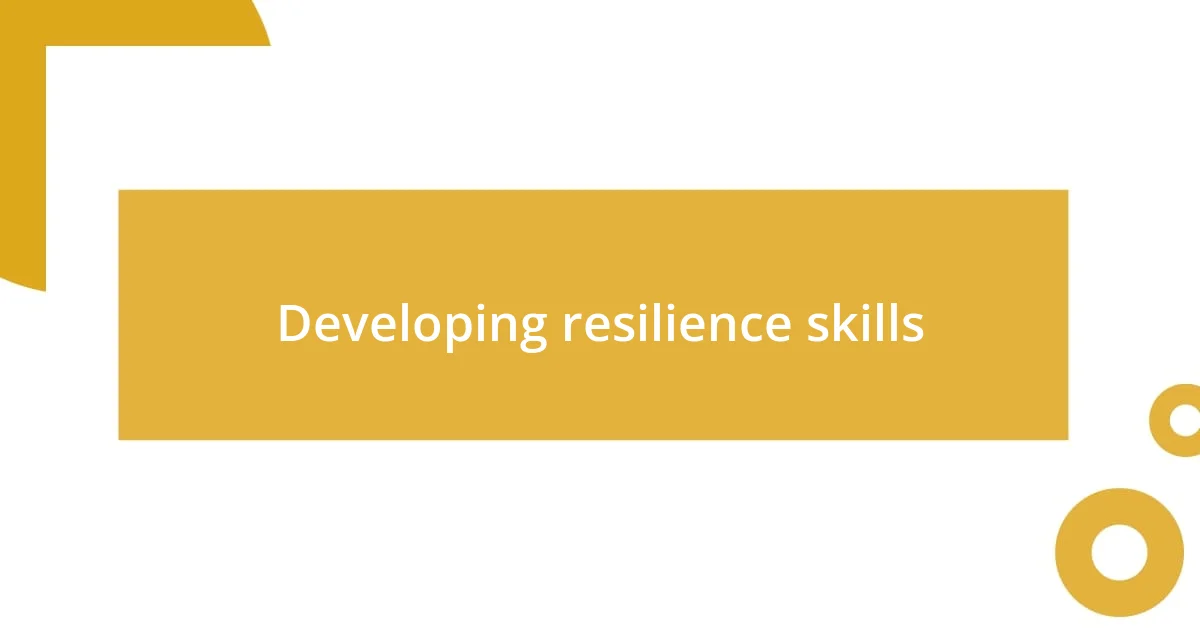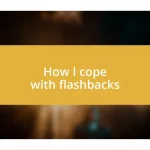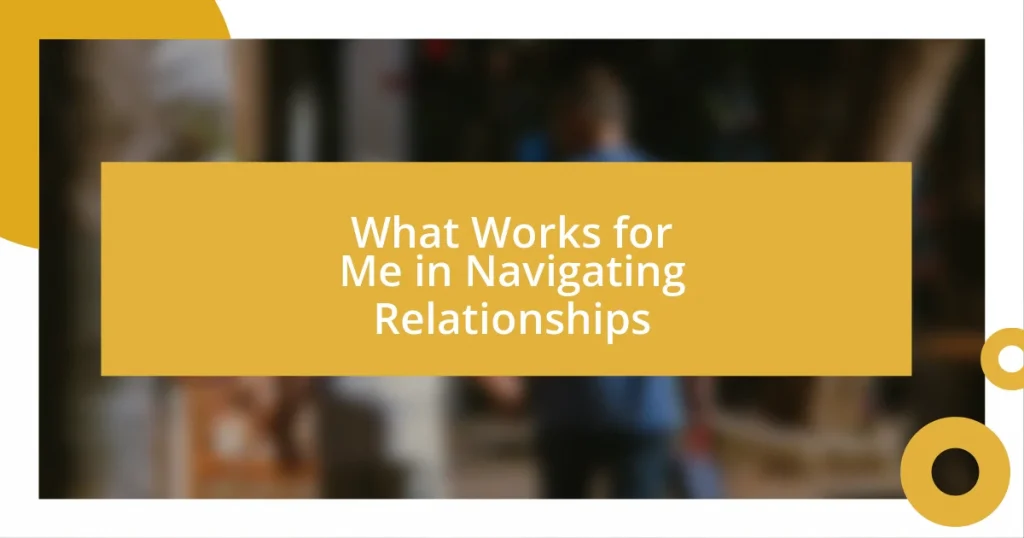Key takeaways:
- Re-traumatization can occur through triggers that evoke intense emotional and physical responses, highlighting the importance of recognizing one’s unique reactions to such triggers.
- Immediate coping strategies like grounding techniques, deep breathing, and reaching out to supportive individuals can help regain control after experiencing re-traumatization.
- Long-term recovery techniques, including consistent self-care, therapy, mindfulness, and developing resilience skills, are crucial for navigating ongoing trauma challenges and fostering healing.

Understanding re-traumatization
Re-traumatization occurs when someone experiences a trigger or event that brings back vivid memories of their trauma, making them feel as if they’re experiencing it all over again. I remember an instance when a seemingly benign situation—a song playing on the radio—flung me back into a painful memory. Have you ever found yourself in a moment that turned into a whirlwind of emotions, leaving you wondering, “Why does this still affect me?”
Understanding re-traumatization involves recognizing that it’s not just about the original trauma; it’s also about how our mind and body respond to reminders. I’ve found that my body often reacts before I consciously connect the dots, leading to heart palpitations or overwhelming sadness, and it’s confusing. Have you noticed how certain smells or places seem to transport you back to a time you’d rather forget?
It’s essential to realize that everyone reacts differently to triggers; some may feel empowered to confront their feelings, while others might withdraw. I’ve learned through my own journey that understanding these responses is crucial. How have your experiences shaped your reactions? Exploring these feelings can help demystify re-traumatization, making it a little less scary to face.

Signs of re-traumatization
Recognizing the signs of re-traumatization is critical for navigating the journey through one’s trauma. I recall a moment when I was in a crowded cafe, and a loud argument erupted nearby, instantly triggering feelings of anxiety I thought I had put behind me. It’s fascinating how the brain associates specific sounds or environments with past experiences, often catching us off guard.
Here are some signs that might indicate re-traumatization:
- Intense emotional responses, such as panic, anger, or sadness, that feel disproportionate to the current situation.
- Physical reactions, including increased heart rate, sweating, or a sense of detachment from reality.
- Overwhelming memories or flashbacks that disrupt daily activities, making it hard to concentrate.
- Avoidance of people, places, or situations that remind you of the trigger.
- Changes in sleep patterns, like insomnia or nightmares, that seem linked to past events.
- Sudden shifts in mood or behavior, leading to withdrawal or irritability.
For me, realizing these triggers is a journey in itself. I remember feeling sudden waves of exhaustion after unexpected triggers, almost like my body was demanding a pause. It’s as if time collapses, and the past merges with the present, leaving me disoriented. Have you ever experienced those moments where you felt like a jigsaw puzzle missing a few vital pieces? Identifying these signs can serve as a crucial step in learning to manage re-traumatization.

Immediate coping strategies
Immediate coping strategies are vital to regain a sense of control after experiencing re-traumatization. One tactic I adopt is grounding techniques, which anchor me to the present. For instance, when anxiety swells, I focus on the details of my surroundings—what I can see, hear, or touch. When I practiced this recently during a tense moment, I found myself counting the number of items in the room to pull my thoughts away from the spiral of panic. It’s amazing how something so simple can shift my focus.
Another effective strategy is deep breathing. I take a moment to close my eyes and inhale deeply through my nose, allowing my abdomen to expand fully before exhaling slowly through my mouth. This practice calms the nervous system and helps me re-center my mind. The first time I tried it, I felt a wave of relief wash over me; suddenly, the fog of anxiety began to clear, allowing room for clarity and calm. Have you tried this approach? I believe it can be a powerful tool in those overwhelming moments.
Lastly, I find it incredibly helpful to reach out to a trusted friend or therapist. Sharing what I’m experiencing brings a sense of validation. When I call a friend during a trigger episode, I not only feel less isolated, but I also gain perspective on my feelings. There’s something about vocalizing those emotions that lightens the burden. Do you have someone you can turn to when emotions come rushing back? Having that connection is invaluable in navigating the aftermath of re-traumatization.
| Immediate Coping Strategies | Description |
|---|---|
| Grounding Techniques | Focusing on sensory details in the environment to divert attention from anxiety. |
| Deep Breathing | Using controlled breath to calm the nervous system and regain focus. |
| Reaching Out | Connecting with a trusted person for support and perspective during intense emotions. |

Long-term recovery techniques
Long-term recovery techniques are essential for me as I navigate the complexities of trauma. One method that has profoundly impacted my journey is establishing a consistent self-care routine. I remember the early days of my recovery when I committed to daily walks. Those quiet moments outside became my sanctuary. Nature has a unique way of soothing the soul, and I often found clarity as I strolled along tree-lined paths. Have you ever noticed how a simple change of scenery can shift your mindset?
Additionally, therapy plays an invaluable role in my ongoing recovery. I’ve been through various modalities—talk therapy, EMDR (Eye Movement Desensitization and Reprocessing), and even art therapy. Each approach resonated with me differently. EMDR, in particular, was eye-opening. I wasn’t sure how moving my eyes back and forth would help, but it felt like unearthing buried emotions. It’s so empowering to unpack trauma in a supportive setting. Could you imagine how transformative it could be when you feel heard and validated?
Another technique that has been a game-changer is mindfulness meditation. I initially resisted it, thinking I’d never quiet my mind. But slowly, with practice, I found that even a few minutes of focused breathing could ground me. There’s something magical about consciously being in the moment, feeling my breath rise and fall. It reminds me that while the past may linger, it doesn’t have to dictate my present. Have you explored mindfulness in your own journey? That awareness can nurture resilience and pave the way for healing.

Building a support network
Building a support network is one of the most empowering steps I took in my recovery. I recall a time when I felt utterly alone, grappling with overwhelming emotions. It was through a local support group that I discovered the strength of community. Sharing experiences with others who truly understood my struggles nurtured a sense of belonging that I didn’t know I craved. Have you ever felt that connection where you know others genuinely resonate with your pain? It’s a reassuring reminder that we are not alone in our journeys.
Finding trusted individuals—friends, family, or even online communities—has also been instrumental. I remember the first time I confided in a close friend about my re-traumatization; it was liberating. She listened without judgment and offered empathy that lightened my emotional load. Knowing that someone cares enough to listen makes all the difference. Do you have those people in your life who uplift you when the burdens feel too heavy to carry? Their support can provide a safe harbor during emotional storms.
Lastly, I embrace the idea of being selective with my support network. I’ve learned that not everyone will understand the complexities of trauma, and that’s okay. Focusing on relationships that foster compassion and safety has been a game changer for me. There’s a profound sense of peace that comes from surrounding myself with individuals who uplift me rather than drain my energy. How have your relationships shaped your path to recovery? Building a solid support network can be a protective wall against the waves of re-traumatization, creating an environment where healing can truly thrive.

Seeking professional help
Seeking professional help has been a pivotal part of my recovery journey. There was a particularly tough week when my memories seemed overwhelming. That’s when I decided to reach out to a therapist who specialized in trauma. From our first session, I felt an instant sense of relief; it was like finally finding someone who understood the depths of my struggle. Have you ever had that feeling of finally being seen?
I’ve learned that finding the right therapist can take time, but it’s worth the effort. I remember attending several initial consultations before meeting someone who clicked with me. It was liberating to express my feelings without holding back, as though a weight had been lifted. The process itself can be daunting—can you relate? But once I found the right fit, the insights and coping strategies I gained became invaluable tools in navigating the aftermath of my experiences.
Engaging in therapy also allowed me to explore the nuances of my emotions. I shared with my therapist how re-traumatization can trigger unexpected reactions, and we worked together to identify my triggers. The safety of that space allowed me to confront feelings I had buried for so long. It’s empowering to have a professional guide you through these tangled emotions. Do you think having someone to help unpack your experiences could change your perspective? I truly believe that seeking professional help isn’t just a step; it’s a leap toward deeper healing.

Developing resilience skills
Developing resilience skills has transformed how I navigate the emotional waves of re-traumatization. I recall a moment when I realized the value of mindfulness, a practice that often feels elusive. By dedicating just a few minutes each day to focus on my breath, I was able to calm my racing thoughts when memories surfaced unexpectedly. Have you ever paused to notice how your body feels in such moments? I find that simple awareness can create a bridge between chaos and clarity.
Another resilience skill that has taken root in my life is the practice of self-compassion. I remember a particularly challenging day when self-criticism crept in, leaving me feeling drained. Instead of succumbing to that inner critic, I decided to treat myself as I would a dear friend. I whispered affirmations that reminded me it’s okay to struggle and that my experiences don’t define my worth. How often do we forget to extend that grace to ourselves? Incorporating self-kindness into my daily routine has made a significant difference in how I cope with setbacks.
Lastly, I’ve found that setting realistic goals plays a vital role in my resilience journey. When I first tried tackling everything at once, I felt overwhelmed and defeated. Gradually, I learned to break larger tasks into smaller, manageable steps. One day, I decided to simply take a walk and enjoy nature rather than expecting myself to resolve all my feelings in one go. It was refreshing and liberating. Do you have strategies for pacing yourself? Fostering small victories along the way has built the foundation for a more resilient mindset, allowing me to bounce back more effectively.














